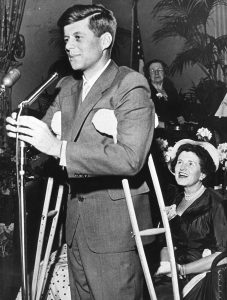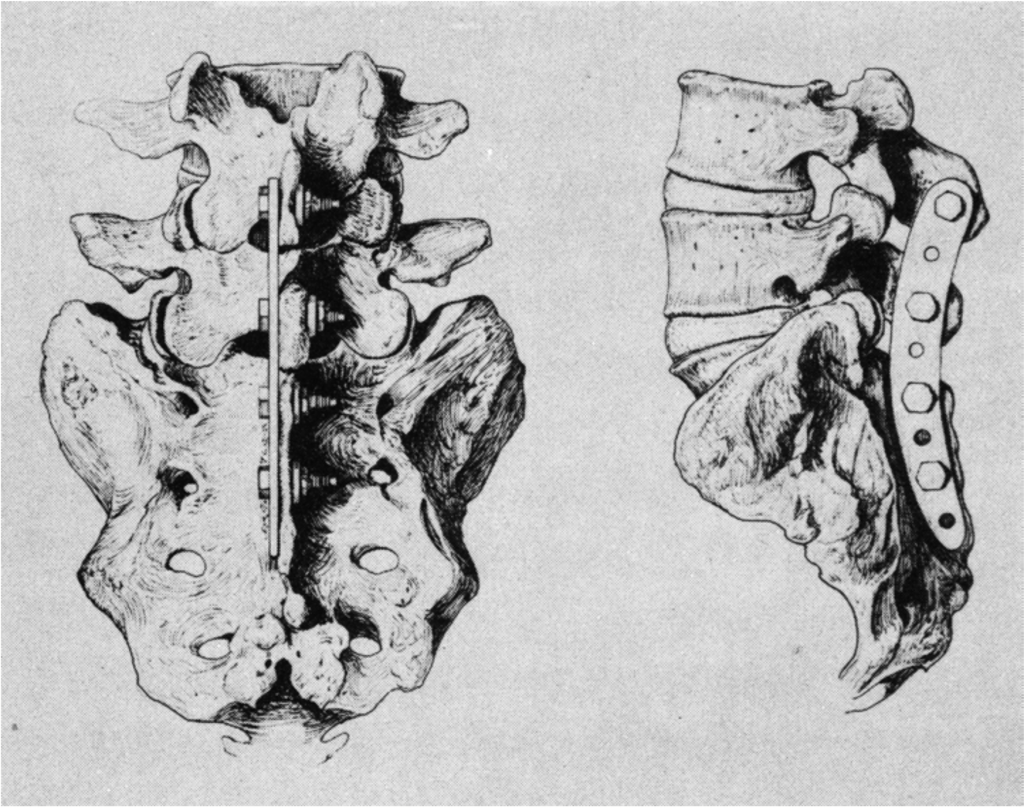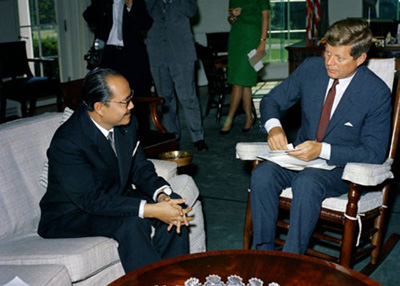
JFK’s Assassination Aided By Back Pain?
Research Shows John F. Kennedy’s Assassination Was Facilitated by His Bad Back.
In an effort to bring more interesting content to the blog, we share this very intriguing story about a great man who was afflicted with tremendous pain, disability and personal suffering. Although he looked fine on the outside – JFK was anything but ‘fine’. He struggled daily with pain. Despite the well meaning doctors and surgical support staff, they only contributed to his injuries and made things worse.
In the end it appears JFK’s spinal pain, medical mistakes, and ongoing disability nearly took his life several times and was most likely implicated in his assassination. He simply could not lie down out of the way of the bullets. He was strapped in a seated position, sweating in a full body brace in the hot Texas sun, on that fateful day.

This photo was taken on November 7, 1936, two weeks before his assassination. Kennedy entertains the foreign minister of Portugal, Alberto Franco Nogueira. Kennedy’s rocking chair was ordered by his doctor to support his excruciatingly painful lower back.
Kennedy’s family hid the true extent of John’s medical problems until well after he died. Though, over the years details of his pain were revealed when he appeared on crutches both before and after one of his numerous back surgeries.
An article written by CNN has uncovered the painful truth of John F. Kennedy’s battle with poor health through most of his life, and suggest that it may be a culprit in his devastating assassination on November 22nd 1963.
Conspiracy theorists have debated for decades about who pulled the trigger, however, a new conspiracy has now risen to the surface. Theorists are now suggesting that it was Kennedy’s tightly laced back brace that may have prevented him from being able to crouch onto the floor of the car after the assassin’s first bullet to the neck.
Dr. Thomas Paid, a spinal neurosurgeon describes Kennedy’s brace as “a firmly bound corset, around his hips and lower back and higher up.” The brace was tightly laced right up to about his nipples really tight, potentially inhibiting his ability to bend forward.
JFK’s Early Health Problems

John F. Kennedy is pictured at age 16 when he played football for the Choate School in Wallingford, 1933.
Kennedy was as sickly child. He had scarlet fever at age two.
He spent his teenage years in and out of hospitals with abdominal and joint pain, flu-like symptoms and extreme weight loss.
At the age of 15, Kennedy weighed a mere 117 pounds, according to research conducted by Historian Robert Dallek. By the next year, worried he might have leukemia, doctors began regularly checking his blood count.
After a bout of tests at the Mayo Clinic, his physicians delivered a different diagnosis: peptic ulcer disease, or what we now call colitis.
Despite a diet of bland foods, constant doctor visits and strong medications, including steroids placed just under the skin to dissolve, his college years at Harvard were plagued by abdominal pain, weight loss and weakness.
Harvard was also the origin of a new ailment: chronic back pain.
It is alleged to have started when he was tackled from the side during a football game, possibly damaging a spinal disc.
Even after graduating from Harvard in June 1940, Kennedy remained plagued with back pain. He was referred to an orthopaedic spine specialist, Dr. Gilbert Haggart, who diagnosed him with a “very unstable lumbosacral joint.”
Kennedy was recommended a course of conservative treatment but was told that if this failed he may be eligible to undergo a sacroiliac fusion.
Unfortunately, his continuing pain affected his prospects of military service. He began regularly using a corset brace to stabilize his spine and control his discomfort.

Harvard Graduation 1940.

Kennedy recovering from one of his many back surgeries and continuing to work on crutches.
The First Back Surgery
Doctors continued to fight about the real cause of Kennedy’s chronic back pain and the best way to treat it.
Part of the problem was the tests used at the time.
Through his research Dr Pait discovered that back then a way of treating chronic back pain was through a procedure called a myelogram.
Doctors would “stick a needle in the back and inject a dye, air or gas to get pictures of the bones and the spaces between them.” Dr Pait said that, “if Kennedy was treated today, we would have better imaging, with MRIs and higher-field magnets and CT scans.”
Kennedy had his sights set on a career in politics. With conservative treatment failing and unable to live with the pain, he made a decision.
Against the advice of his doctors at Mayo, he underwent spinal surgery in June 1944, at New England Baptist Hospital.
He was admitted to New England Baptist Hospital and on June 23 he underwent a left L4–5 laminotomy and L5–S1 discectomy performed by Dr. James Poppen, neurosurgeon at the Lahey Clinic. Kennedy was doing well for the first two weeks following the surgery.
However, when it was time for him to get up he had severe muscle spasming in the low back. To keep him comfortable he was given high doses of narcotics.

Senator John F. Kennedy addresses the State Federation of Labor Convention in Worcester, Massachusetts, on Aug. 4, 1954. Kennedy was often on crutches due to back pain.
Congressional Years
Kennedy declared his candidacy for the US House of Representatives, Massachusetts 11th district in April 1946. His campaign exhausted him and resulted in daily back rubs, hot baths, and regular use of his back brace. Despite the pain, Kennedy kept working hard and in 1952 he was elected to the US Senate.
In October 1954 Kennedy proceeded with surgery number two, a lumbrosacral fusion operation.
After a metal plate was inserted in his lower back to fuse his spine, he developed a urinary tract infection.
He got so sick, the family called a priest to administer last rites.
“Jack was determined to have the operation. He told his father that even if the risks were fifty-fifty, he would rather be dead than spend the rest of his life hobbling on crutches and paralyzed by pain.” – Rose Kennedy, John’s mother, in her memoirs.
Unfortunately, Kennedy never fully recovered from the fusion surgery.
Kennedy had developed a staphylococcal infection, which can be described as an open, gaping. very sickly hole in his back.
In an effort to treat the infection, Kennedy underwent his third operation.
Kennedy’s next solution was to turn to muscular injections of procaine, a version of lidocaine, a numbing agent that blocks nerve signals to the brain.
According to research conducted by Dr Pait and Dr Dowdy, he would receive “hundreds, if not thousands,” of injections over the next four years, which along with muscle strengthening and use of the corset produced “dramatic” improvement in his back pain.
Presidential Election and Back Pain Relapse

Senator John Kennedy leaving the hospital with his wife Jackie to be with his family. This image was taken two months after his second spinal fusion injury in 1954.
The grueling campaign leading up to his election as President in 1960 again took a toll on Kennedy’s back pain.
He sought the services of Dr. Max Jacobson, “Dr. Feelgood.”
Dr. Feelgood injected Kennedy with amphetamine-based concoctions.
Dr Pait says that Jacobson’s “secret formula was thought to have some methamphetamine in it…and it made the president feel fantastic.
He was high. And he was not in pain.”
During the early term of his presidency, Kennedy found himself physically in the worst condition.
He returned to crutches, procaine injections, his corset brace and increased the amount of illicit injections from Dr. Feelgood.

The Wilson plate used in JFK’s second surgery to fuse his spine. It was removed months later.
.
“He was one of our youngest presidents, and he was also one of our sickest presidents. Yet it was important politically for him to keep up the appearance of youthfulness and vigor.” – Dr. Thomas Pait, Spinal Neurosurgeon.
.
A More Conservative Approach

Kennedy sits in his rocking chair during a meeting with Prince Tiao in Khampan, 1961.
By the end of 1961 there were growing concerns about Kennedy’s use of Dr Feelgood’s injections.
As a result, White House Physician, Vice Admiral George Burkley, took over Kennedy’s care. He brought in a new doctor, Dr. Hans Kraus, who established a multidisciplinary pain centre in the late 1950s.
Kraus believed that much of Kennedy’s back pain originated in weak and deficient muscles.
He attempted to wean the president off the back brace with a regimen of weight-lifting, swimming, massage and heat therapy.
This new approach had dramatic results for Kennedy and he was actually on a path to recovery for the first time in his life.
In August 1963, not long before his visit to Dallas, Kennedy strained his back and again started relying on his back brace.
“Kennedy said to Kraus, ‘Look, I tell you what, when I come back from Dallas, I’ll get out of the brace, but I gotta wear it for this trip. I gotta look good.’ He wanted to be able to sit up tall and wave at people,” Dr Pait explained.
Sadly we will never know if Kennedy would have survived that second bullet, that ultimately took his life, had he not been wearing his brace that day.
The Spinal Centre Comment
At the time of Kennedy’s multiple surgeries the procedures were considered “state of the art.” This did not mean, however that they were always effective.
Dr. James Poppen, the neurosurgeon that performed Kennedy’s first spinal operation, made the following comment six weeks after Kennedy’s operation, “I have had nineteen other patients in a series of over five hundred ruptured intervertebral disks with a similar experience [as Kennedy].”
It was not just Kennedy that had a bad experience, this is something encountered by many that went under the knife before more conservative measures were considered more thoroughly.”
Interesting and disturbing. It is a high failure rate.
For Kennedy and so many others, surgery was not the answer.
Kennedy even said himself, “In regard to the fascinating subject of my operation…I think the doc should have read just one more book before picking up the saw.”
Despite this, desperation for pain relief led him to undergo surgery two more times after this comment.
Dr Pait and another neurosurgeon, Dr Justin Dowdy, have closely examined the x-rays from the time of Kennedy’s surgery and both found no abnormalities in the spaces between vertebrae and no sign of underlying bone disease.
It was a hell of a price to pay for pain relief.
References
LaMotte, S. (2017, November 3). JFK’s assassination aided by his bad back, records show. CNN. Retrieved from https://edition.cnn.com/2017/11/22/health/jfk-assassination-back-pain/index.html.
Pait, T., Dowdy, J. (2017). John F. Kennedy’s back: chronic pain, failed surgeries, and the story of its effects on his life and death, JNS Spine 27, 247-255.
The Spinal Centre – Neuro-Musculoskeletal SolutionsThe Spinal Centre provides the Best Natural Medicines, Health Products and Nutritional Solutions to Free You of Pain and Improve Your Spinal Health.The Spinal Centre is a leader in the management and treatment of spinal pain and disability including:
- Chronic Back and Neck Pain
- Cervical and Lumbar Disc Injuries with or without neruological changes
- All forms of arthritis including rheumatoid arthritis, psoriatic arthritis and osteoarthritis
- Neurodegenerative diseases such as Parkinson’s and Alzheimer’s disease
- Neuromuscular problems such as chronic back pain, headaches, migraines, neck or spinal pains
- Myofascial pain syndromes such as fibromyalgia, diffuse muscular or joint pains
- Austistic spectrum disorders including ADD, ADHD, learning difficulties and autism
- Fatigue, energy and mood disorders including chronic fatigue and depression
The Spinal Centre focuses on resolution with the development of individualised treatment programs using Conservative and Integrative Medicine; combining genetic, metabolic and nutritional testing with specific natural medicines to enhance your health and achieve your genetic potential.We have helped thousands – Why Not You?





